A Future With Falconry
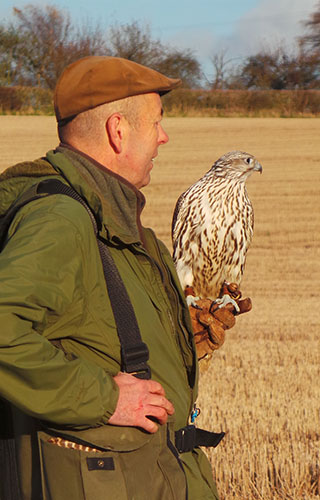
This year (2020) sees my 50th year of falconry. At the age of 8 and with a fascination of all things nature and birds of prey in particular, I could never have dreamt where my future with falconry would have taken me.
With limited access to Kestrels and Buzzards at the time, classic books written by the masters of the sport were my world. I never dreamt that I would have access to Goshawks, magnificent Peregrines, impressive Gyrfalcons and that I to would participate in the same Grouse hawking I had once read about.
For 18 seasons I found myself employed as what is understood to be the last true professional falconer in the UK. A person who is solely employed to train hunting hawks and falcons for no other reason than for the sport and enjoyment of his employer - in my case the late John Fairclough.
A dream job for many, but in reality an extremely hard one with untold pressure. Fortunately this is something I thrive on. It taught me valuable lessons which I still put in to practice today with my own team of falcons. Whatever level of falconry you pursue, however long you have been practicing it, there is always something new to learn. As with everything, new ideas or technology comes along which can help improve the quality of our art, but more importantly the health and welfare of our charges - something which should constantly be at the forefront of our thoughts.
Having been asked to contribute to AFWF, I thought some of the important key points I use in management of my team, training and hunting may be of interest to those with a desire to know more, those who have just started or as an insight to more experienced falconers who may benefit.
My passion for falconry runs very deep and I continue to try and promote it in its true form and to as high a standard as I possibly can, with an open door to any falconer for advice or to join me for a day to see what I do. This is not about self-promotion, rather supporting the continuation and improvement of our beloved sport.
Before I go further, I must stress that the following is based on how I choose to manage and maintain my falcons. This is my way, not the only way. We all have our little traits or particular way of doing things. It works for us but must never be set in stone. We must remain open minded and strive to achieve the highest standard of gamehawking possible, prioritising the highest performance on the ground available to set the standard.
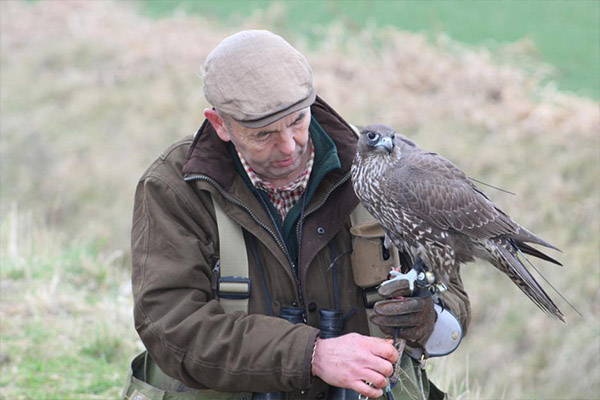
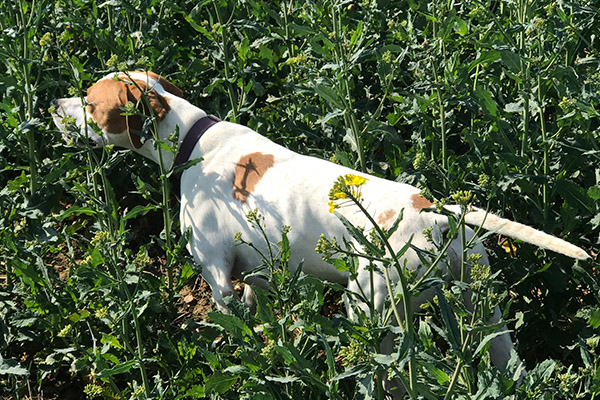
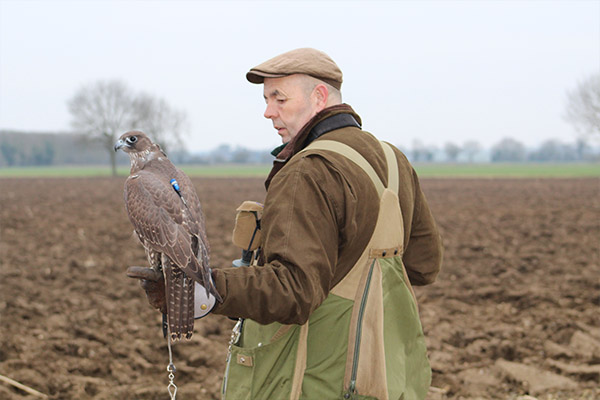
Having flown many types of hawks and falcons, I now concentrate on hunting partridge and pPheasant. For this I fly a team of three falcons and I'm fortunate that once they are reclaimed after moulting in mid August, I can concentrate all my time on them until the end of the season by hunting every day, weather permitting. I strive to achieve the highest standard of gamehawking as possible - striving to achieve high pitches, ones that are practical for the ground I hunt, which accommodates heights of 1000 feet plus. Some game is released, and this has a huge positive contribution to both conservation and increasing naturally produced game numbers.
This is particularly the case for grey partridge, which are now in healthy numbers on lots of areas that we have been releasing on for several years. Prior to this their numbers were low, but due to careful management alongside falconry they are much improved. Any introduced game is only flown once it is mature, settled and aware of its surroundings and is as close to wild game behaviour and fitness as possible. I prefer parent reared falcons as opposed to imprints and have little interest in breeding, preferring to leave that to those who have and have the experience, many of who I am in debt to for providing me with top class falcons.
Furniture
Once any new bird is acquired, it must have the correct furniture put on. This refers to Jesses, leash, swivel, telemetry mounts and hoods. All must be of good quality and most importantly be the correct size for the particular bird. Whatever type of jess you choose, it must not be too tight or to loose. Both cases can cause unnecessary injury or loss of a bird. Leather jesses must be treated regularly to remain supple and must never be allowed to go stiff, which again can cause issues.
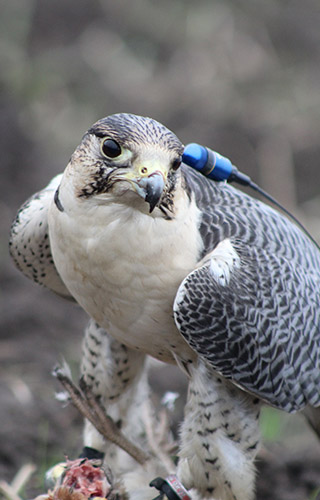
This season I have used the 'Kaiser slip on' anklets and found them extremely useful in many ways. When fitting on a new falcon, newly taken up and in a wild state of mind, they can be put on in less than a minute reducing the stress of the situation immensely for both falconer and most importantly, the falcon. Another aspect I like about them is that once a falcon is manned sufficiently, they can be removed and treated both outside and inside, something which was impossible to do with traditional type jesses. I do this while the falcon sits hooded on the scales and they are removed and replaced one at a time.
I always used to make my own leather jesses, preferring kangaroo, to slip through the Aylmeri type anklet or now, the 'slip ons'. Leather is very traditional but needs regular maintenance. I now use braided jesses which I am very impressed with and find the ones by Hooded Talons suit my needs. I have them made to the length I need for each falcon. They need little or no maintenance and have had little trouble with falcons pulling at them, even with the larger powerful Gyr falcons. My choice of swivel is always Sampo's, of size to suit the falcon, not to large or too small.
Telemetry, which everyone should use when flying any bird free, is available to suit various budgets and has progressed tremendously in recent times. I always fly with two transmitters for safety. I am not relying on just one method of tracking, or should one fail I have back up. My choice is Marshall Radio Telemetry. I fit a backpack to all birds and when flying free, fit a GPS Transmitter to this with an RT Turbo UHF transmitter via a tail mount or leg mount depending on the size of the falcon. By doing this I have never lost a falcon for a long period and they are quickly and easily tracked and recovered. The use of GPS has greatly improved the training and flying of falcons and I have certainly learnt a great deal on what my falcons do, and it has removed guess work from pitches, climbing and position at high altitudes.
One of the most vital pieces of furniture for any falcon is the hood. It is so important that this is a perfect fit for many reasons. If not, all sorts of issues can arise. Damage to the bird itself, such as sores or abrasions to the cere. No matter how well made a hood is, how expensive or nice looking it is, it must be fitted correctly and will often need adjustment to the aperture to fit correctly. This must be done by softening with water and very gradually trimming it back to suit but be careful not to overdo it. Too much off and the hood will be useless as the Falcon will be able to see. Once trimmed and still damp, gently pinch the sides of the hood, closing the aperture to fit snuggly to the birds cere and leave to dry, off the bird of course. An incorrect hood could make a bird hood shy, even if it is introduced correctly. A good well made Dutch hood suits my needs and currently I use a one piece hood made by a talented UK hood maker, DS Hoods.
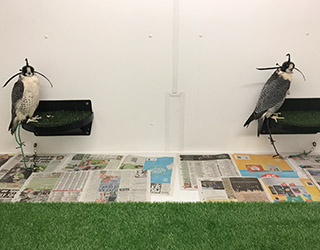
For my team I use colour coordinated braided Jesses, so each bird retains its own furniture all the time. This goes for gloves too. Chris Payne makes my gloves, all single skin, but with a slightly different coloured cuff. I use one glove per bird, so the colour identifies which is for which bird. The main reason for this is so there is no possible transmission of anything infectious from one bird to another.
Strict hygiene plays a huge part in my daily management. For instance, scales are sprayed with an F10 solution between birds. Birds feet are also checked and cleaned daily especially after hunting. Gloves, lures, food pouches and block tops are cleaned at the end of every day as too are the cadges and shelf perches. My wife says I must have OCD and some may say it's a little overboard, but prevention is always better than cure. Should a falcon have been on the floor and dirtied its tail, then this would also be cleaned and dried before putting away.
Weathering
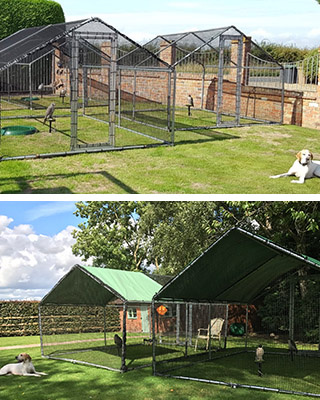
This is a vital part to any bird's welfare, training and routine. They must get sufficient sunlight, but not left to overheat, must not be left in shade during cold conditions and also be protected from severe weather. I use a moveable secure pen, netted on all sides and roof.
A 4m x 3m is easily moveable and can generally accommodate two falcons. A cover can be placed over the roof during heavy rain and being moveable, can be on fresh ground regularly.
It also protects the falcons from other predators and should there be an unlikely equipment failure, a bird will not be lost. They should be offered a bath daily and tethered so they cannot reach each other or the sides of the enclosure.
Training
If I were to go fully into my training methods this would end up more like a book than a blog. I will generally cover what I regard as key points:
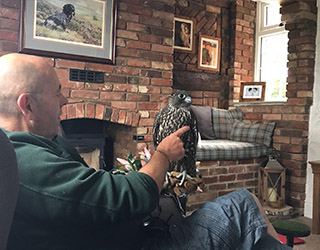
Initially, the manning time is made up of short sessions until a falcon will start to take small amounts of food and is made to the hood. There is no rush, no time scales to work to and it's never a competition to see how quickly it can be done. All birds are individuals, they don't always follow the same pattern and often have personal traits that the falconer has to identify and adapt to. What works for one doesn’t always work for another.
I like to man my falcons and look for birds that accept my presence at any time and all situations. It's what I desire but not always achieved. One falcon at present only really likes to be handled at hunting time or afterwards. Beforehand he prefers to be weathered and given his own space, whereas his half brother is always happy to be picked up at any time. Training should not be rushed but equally not to slow. I look for a natural progression alongside natural development. I'm a traditionalist and weigh my birds daily, but only to assist the reading of the bird's behaviour and later alongside consistent performance.
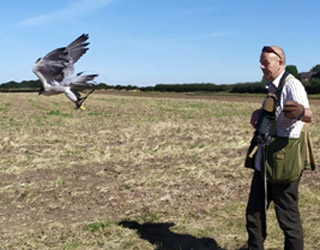
Once a bird is manned, feeding and jumping to the fist I start lure training and from the first introduction to the lure it is always fully fed once produced. This carries on through calling off training, and is only ever called to the lure once and fully fed. This continues to hunting and throughout its career. I have a policy that if I show the lure, in any circumstances, it will always be allowed to receive it and fully fed. There are occasional situations where as a made falcon it may be called to a lure and given a small amount then flown again, but as I generally only hunt a falcon once a day, this is very rare. I call it my trump card. If things go wrong, the falcon is conditioned to know that once it sees the lure, it's theirs and can often get me out of a sticky situation quickly.
Once long distance calling to the lure is achieved, I look at going to the next step. I only ever straight line a falcon to a lure. I never stoop them as these are to be game hawks and required to wait on and stooping to a lure would be detrimental to their pitch and is more suited to falcons that are used for pursuit type hunting.
Drones
One of the recent innovations in training aides is the use of drones. These enable us to replicate what would happen in the wild with parent falcons taking prey to heights and encouraging their offspring to follow them up therefore teaching them about altitude and how to climb.
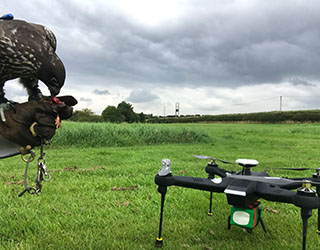
I have found drones to be a tremendous asset to my training for a number of years now, and have had great success with all I have trained with them. Not only with my falcons but with other falconers and their birds too. I use a custom made model which unlike a lot of the commercially available types has a great flight time, will fly in strong wind without adversely affecting battery life and importantly when training large falcons, will carry a heavy bait or lure.
I teach my falcons to fly up to the bait below the drone. The drone is always set at the height I want them to go to before the falcon is unhooded and allowed to look and take to the wing. I am always cautious of not over doing drone work and once a respectful height has been achieved 4-6 times I will remove the Drone and start educating on game. If I encounter an issue with a new falcon such as poor positioning over me, loss of pitch etc then I may revert to the drone for a few flights to help overcome the issue.
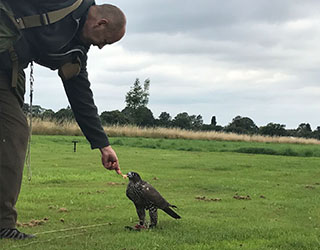
A falcon that flys to a drone is not guaranteed to mount high straight away, but it always gives you a good place to start from and with a falcon that has the fitness and knowledge of how to mount to some degree. Education on game while hunting will always remain the key to making a high flying game hawk.
One thing I will say is that drone work does make a bird fit and I always put my made falcons through some drone work prior to hunting every season. My gyr falcons benefited from regular drone pitch training throughout the season between hunting trips. I have found this really beneficial with the current female gyr whose performance doubled its pitch last season using this method. What can sometimes be difficult is getting a made game hawk that has hunted and been successful at game to keep its interest in the Drone. This is when the falconer has to use a bit of ingenuity and most can be switched back to it.
Hunting
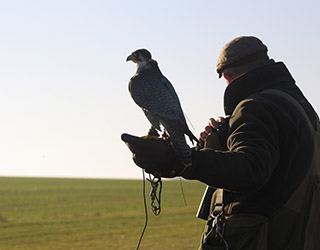
Once I have completed drone training then we are ready to start hunting. No matter how well schooled and conditioned a falcon is, this is when you are never sure exactly what is going to happen. Up until now the falcon has always had a focus - initially your fist, then lure or the bait below the drone; so it has always had something to focus on and fly at. Now it all changes. Once the quarry is located, the young falcon is unhooded and given the opportunity to look around. Initially they always look for the drone but that is not there anymore. After a rouse and a mute, they usually take to the wing or in odd cases may need to be cast off. This is when you have to be quick thinking and ready for anything.
Do not expect the falcon to mount perfectly and high. Very rarely have I had a falcon get really high on its first droneless flight. One of my current falcons was the exception. After doing respectful heights to the drone he achieved an impressive 1500 feet on his first flight without the drone. Sadly, the pitch was nowhere near us and ended in a track down, but the falcon has gone on to achieve some breath taking pitches during his career so far.
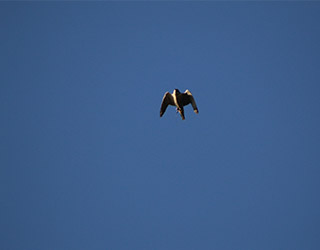
To start with I'm looking for a reasonable effort - 200 to 300 feet. Regardless of position, I want to show the falcon the flush. I'm not trying hard to catch game, just educating the falcon. I want it to realise that I am now the anchor and to watch me to a degree, but not to be totally fixated. The early attempts at game usually end up with an out of position flush and chase. Hopefully in time you can leave the falcon on the wing longer and longer, and look to flush as its pitch increases.
If it has attained a reasonable pitch and deserves the reward, then I flush at the best possible time to help it achieve success. If it's not high enough or is at the same pitch as its previous attempt, then I will wait until the falcon is out of position either down wind or a long way out and then out flush it.
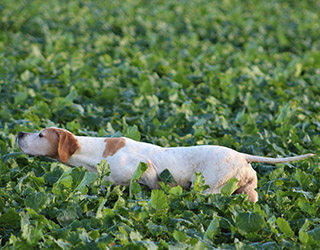
The basic principle is height equals success. Very rarely does it happen quickly. It's only with repetition and discipline from the falconer that the pitches increase. Occasionally even with an out of position flush the falcon may succeed, and on the odd occasion this will not be detrimental but if it happens regularly or the falconer becomes too focused on the end result, then achieving of a consistent high flyer could be lost. I reward any success of a kill by allowing the falcon to take a good feed, enough so that he feels the reward and will not fly the next day, but will be ready for the day after that. I only ever fly a falcon once a day and with a new one, despite the outcome, it is always fed after one flight.
Once some sort of consistency starts to show and position over you is becoming evident, then further pitch conditioning can be done. Many falconers who have come out with me have been astonished to see me purposely out flush a falcon that they regarded as being at a good pitch. I have a minimum pitch that I will flush for my falcons once they know what it is all about, and that is 600 feet.
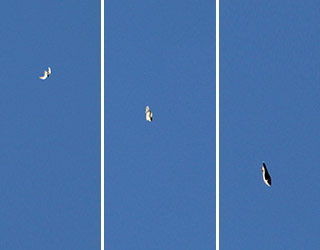
Anything less will result in an out flush or lure down. By doing this, and with the use of the GPS, my falcons reach great pitches. Something else I always insist on is never flushing if a falcon is gliding or levelled out. Reward a climbing falcon every time where possible. Doing so will mean that on a long walk into flush game the falcon keeps climbing and dominating the sky therefore holding the game and achieving a great pitch, often out of sight.
To maintain high pitches there has to be lots of self discipline on the falconer's behalf. Just having another success should never cloud your decision. Never fly in weather conditions that would restrict the falcon's ability to fly high and force you to reward from a much lower than normal pitch. Never fly high flying falcons in enclosed country that would give the game the advantage of reaching cover before the falcon has finished its stoop. If you only have enclosed country, then train to a maximum pitch that will suit the ground and give your falcon success.
We are blessed with some great open ground that allows us to train to great heights and no matter how many times I witness it, the sound of a falcon ripping through the air in its latter part of the stoop prior to closing in on its quarry, will always leave me breathless.Position
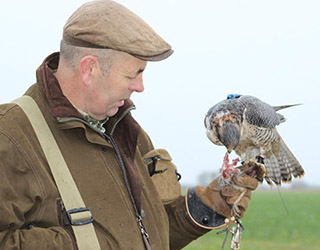
A key to ending a flight successfully is flushing game for the waiting falcon when it is in the right position. You must remember that the game you are flying at knows all the tricks of survival and will use any advantage it can to avoid capture. If you flush with a young falcon directly overhead and not at a great pitch, despite your best efforts game could escape into the wind, often underneath the falcon and use its advantage of being able to easily drop on to the ground, a manoeuvre more difficult going down wind.
Being too up wind or too far in any direction can automatically give the game the upper hand. A falcon that is not responding and coming over will often result on game seeing its chance to get away and flushing early leaving the falcon with no chance. A discrete distance should be given to the game to allow a high flying falcon time to get to pitch and return. Once back and high, no game is going to leave early, and the falcon can be left to go even higher.
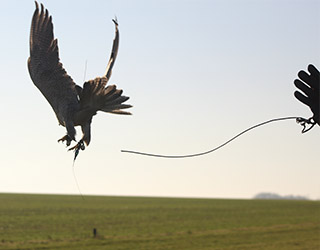
Once great pitches are achieved, necessary down wind flushes are not always the case, and so long as the wind is not excessive a flush in any direction can still result in success.
I have found with the much larger falcons I fly (gyr falcons), that position when flushing takes on another aspect. As these falcons are so large, they intimidate the game far more and if too much overhead in a commanding position the game will be far more reluctant to flush, often running or flying a short distance before putting in again.
What I intend to do is flush when the falcon is returning at pitch but still some way out or has turned away from me and is climbing way out again. Flushing at that point leaves the game with more chance of making a good flight away and with the power of these big falcons they soon make up the ground. What you do not get is the steep fully closed up stoops, but they still achieve incredible speeds and are very impressive.
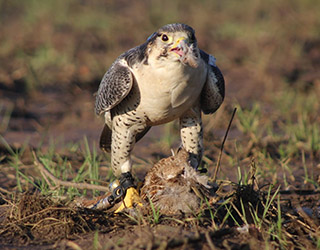
Falconry is and always will be hunting prey in its natural state with trained birds of prey. For me, it is just that and always will be.
I am the first to admit that I am in a very fortunate position to follow my passion to the extent and time spent that I do and will continue to strive to achieve the highest standard possible - from impressive pitches and with well conditioned falcons and well trained dogs.
The actual numbers caught are small and irrelevant, but so long as we continue to promote what we do in its true form and to as high a standard as possible with total respect for our birds and the game we hunt, we all may have a future with falconry.




